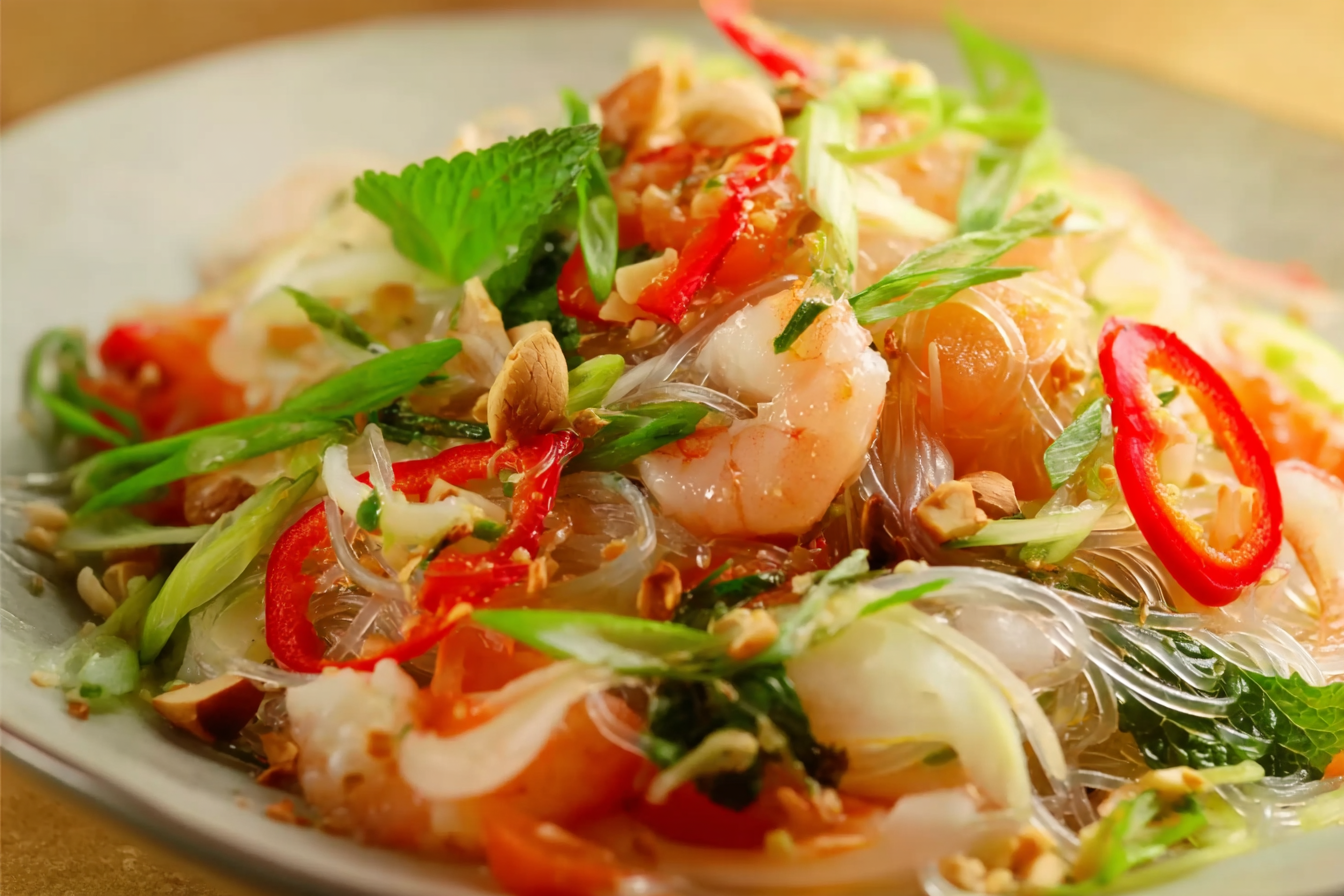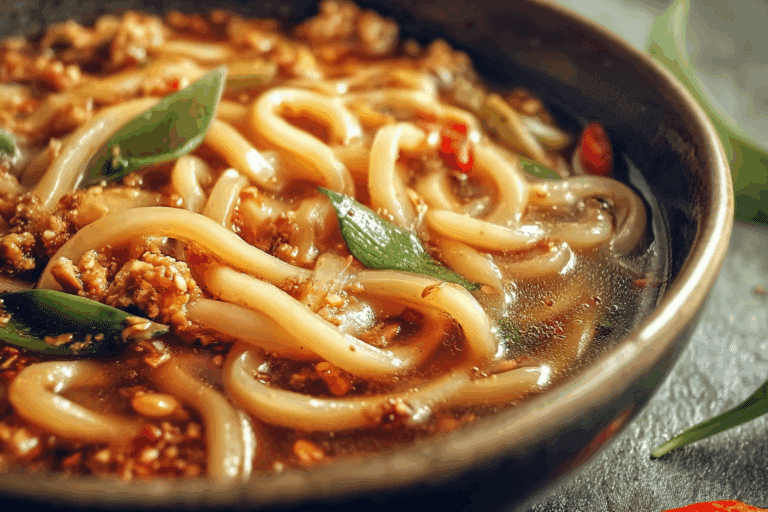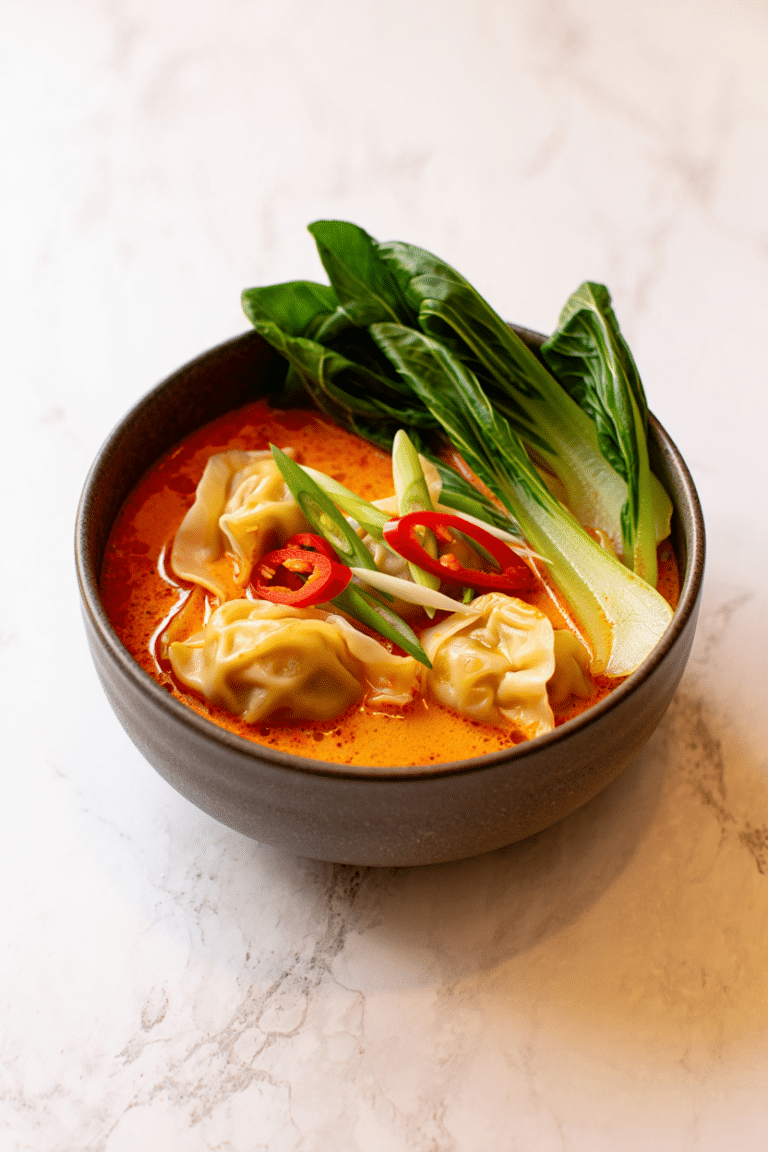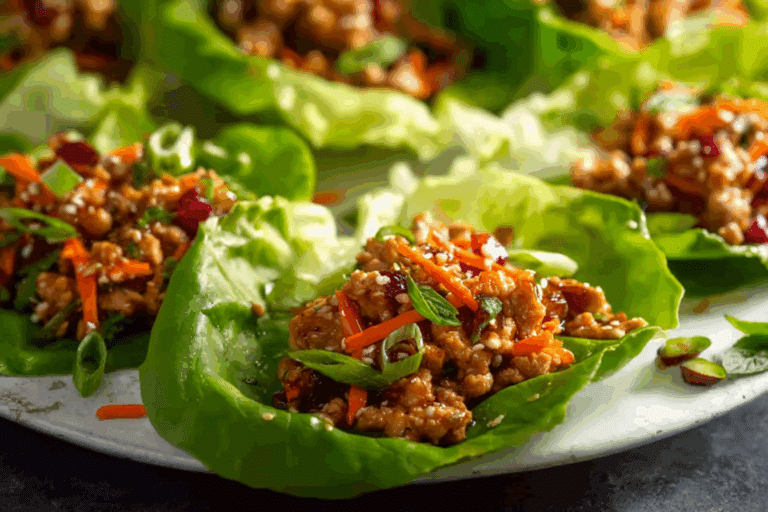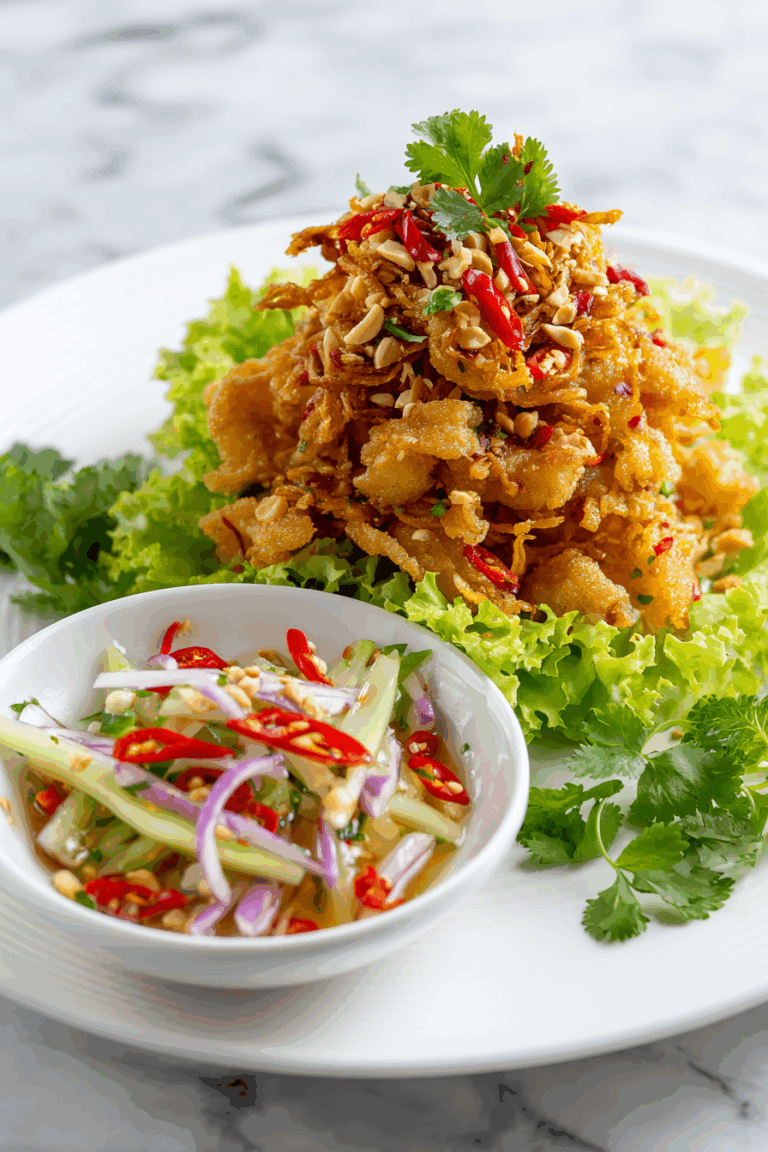Thai Glass Noodle Salad: Discover the Secret to Authentic Taste
Thai Glass Noodle Salad, also known as Yum Woon Sen, is a refreshing dish bursting with authentic Thai flavors. It combines chewy glass noodles, crunchy vegetables, fresh herbs, and a tangy-sweet dressing to create a light yet satisfying meal.
At Just Thai Recipes, the story of Lina, the passionate cook behind the recipes adds an emotional connection to this dish. According to the About Page, Lina began this culinary journey with her partner to share the vibrant tastes of Thailand with food lovers worldwide. This article will guide you through everything about Thai Glass Noodle Salad, from its history and ingredients to preparation techniques, health benefits, and expert tips to make it perfect. Don’t miss our Thai Coconut Pancakes for a sweet ending after enjoying this savory salad.
Table of Contents
Table of Contents
Understanding Thai Glass Noodle Salad
What is Thai Glass Noodle Salad (Yum Woon Sen)?
Thai Glass Noodle Salad, called Yum Woon Sen in Thai, is a zesty salad made with translucent glass noodles, proteins like shrimp or ground pork, and an aromatic lime-fish sauce dressing. It’s a staple in Thai cuisine, known for its balance of spicy, sour, salty, and sweet flavors. The salad often includes fresh vegetables, herbs, and crushed peanuts to add texture. Unlike heavy Western salads, Yum Woon Sen is light yet packed with flavors, making it perfect for both lunch and dinner. This dish’s name translates to “spicy noodle salad,” highlighting its signature taste.
The Cultural Significance of Yum Woon Sen in Thai Cuisine
Yum Woon Sen is more than just a salad; it’s a representation of Thai culinary philosophy balance and harmony in every bite. Traditionally, it’s served at Thai gatherings, street food markets, and family dinners. Its refreshing nature makes it ideal for Thailand’s tropical climate. Over time, it has become a favorite worldwide because of its versatility you can make it with seafood, pork, or even keep it vegetarian. The flavors of the dish speak to Thai culture: bold, vibrant, and unforgettable.
Thai Glass Noodle Salad Ingredients
Essential Ingredients for Authentic Thai Glass Noodle Salad
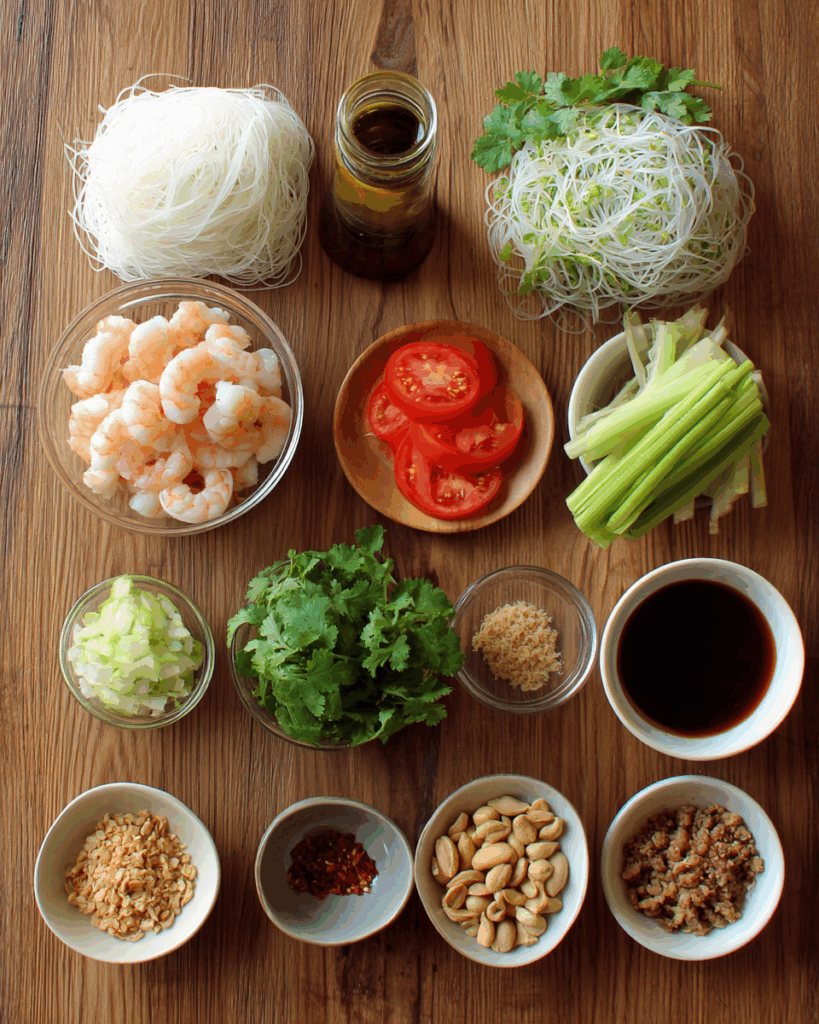
The magic of Thai Glass Noodle Salad lies in the quality and harmony of its ingredients. Here’s what you’ll need to create the authentic taste of Yum Woon Sen:
- Glass Noodles (Bean Thread Vermicelli): These transparent noodles, made from mung bean starch, become pleasantly chewy after soaking. They absorb the flavors of the dressing beautifully.
- Shrimp: Fresh shrimp is commonly used, adding a sweet, briny taste. You can also use squid or other seafood as alternatives.
- Ground Pork: A small amount of ground pork enriches the salad with savory depth.
- Dried Shrimp: Optional but highly recommended for its umami punch.
- Fresh Vegetables: Tomato wedges, julienned onion, and thinly sliced Chinese celery (or regular celery with leaves) provide crunch and freshness.
- Roasted Peanuts: Roughly chopped peanuts add texture and nutty flavor.
- Herbs: Cilantro is essential, giving the salad a burst of aromatic freshness.
- Dressing Ingredients: This tangy, spicy dressing combines fish sauce, fresh lime juice, Thai chilies, garlic, and palm sugar. It’s the soul of Yum Woon Sen, offering the perfect balance of flavors.
Don’t miss our Pandan Juice to pair with this salad it complements the dish with a refreshing Thai beverage.
Exploring Variations: Vegetarian, Prawn, and Pork Versions
One of the reasons Yum Woon Sen is loved globally is its adaptability. You can customize it to suit your preferences or dietary needs:
- Vegetarian Thai Glass Noodle Salad Recipe: Replace fish sauce with soy sauce and skip the meats. Add tofu or mushrooms for protein while keeping the salad light and flavorful.
- Thai Glass Noodle Salad with Prawns: This is the classic seafood version, where juicy prawns star alongside glass noodles and herbs.
- Pork and Shrimp Combo: The traditional combination that balances land and sea flavors, making the salad hearty without being heavy.
- Spicy Variations: Adjust the number of Thai chilies to your spice tolerance. Some regional recipes go extra hot!
- Low-Carb or Health-Conscious Versions: Use fewer noodles and increase the portion of vegetables to make it lighter while retaining flavor.
The variety of Yum Woon Sen Thai glass noodle salad ingredients makes this dish suitable for every palate, from spice lovers to those seeking a refreshing, balanced meal.
Step-by-Step Guide to Preparing Thai Glass Noodle Salad
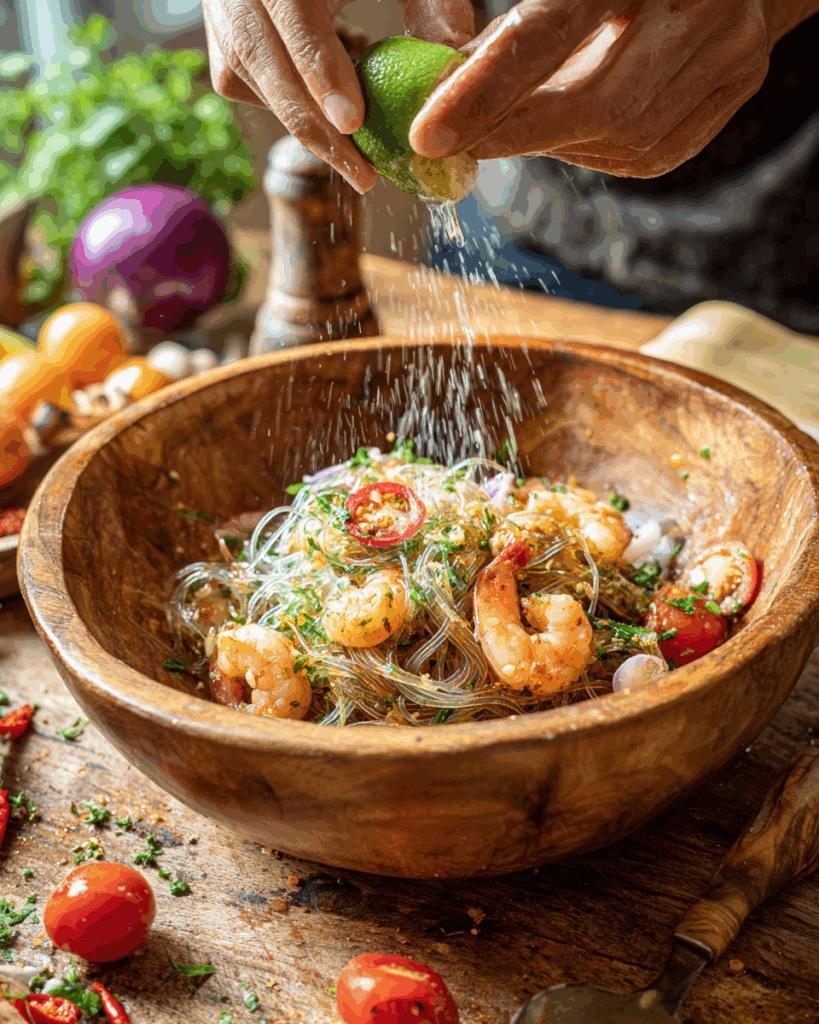
How to Cook Glass Noodles Perfectly
The texture of glass noodles is crucial in making an outstanding Thai Glass Noodle Salad. Follow these steps to get it right:
- Soak the noodles – Place dry glass noodles in room temperature water for 7–10 minutes until they become soft and pliable.
- Cut for convenience – Drain and cut noodles into 2–3 sections with scissors to make them easier to mix and eat.
- Quick boil – Drop the noodles into boiling water for just 2 minutes. Overcooking will make them mushy.
- Drain and cool – Immediately transfer to a strainer and let excess water drip off. Set aside while preparing the other components.
Mixing the Perfect Yum Woon Sen Dressing
The heart of this salad lies in its Yum Woon Sen dressing a bold mix of sour, salty, sweet, and spicy. Here’s how to make it:
- Pound garlic, Thai chilies, and cilantro stems together using a mortar and pestle until you have a rough paste.
- Add palm sugar and continue pounding until dissolved.
- Mix in fish sauce and fresh lime juice to create the perfect balance of flavors. Stir until the sugar is completely dissolved.
- Taste and adjust: add more lime for sourness, more sugar for sweetness, or more chili for heat.
Assembling the Salad
- Prepare proteins – Boil shrimp for 30–45 seconds until pink and cooked. Cook ground pork in a bit of water with fish sauce until fully done.
- Mix ingredients – In a large bowl, combine boiled noodles, cooked shrimp, ground pork, tomato wedges, onion slices, Chinese celery, and crushed dried shrimp (optional).
- Add dressing and toss – Pour the dressing over and quickly toss everything together so the noodles absorb the flavors.
- Finish with herbs and peanuts – Add chopped cilantro leaves and sprinkle roasted peanuts on top for a crunchy finish.
For another authentic side dish to enjoy with your salad, check out Thai Coconut Rice; its creamy texture complements the zesty salad perfectly. Also, if you love Thai desserts, don’t miss the Thai Milk Tea Crème Caramel it’s the perfect sweet ending.
The Role of Fresh Herbs and Spices
Key Herbs that Elevate Thai Glass Noodle Salad
Fresh herbs are not just garnish in Thai Glass Noodle Salad—they are flavor builders. Cilantro is the star, adding a refreshing and citrusy tone that balances the heat and tang of the dressing. Thai celery or regular celery leaves provide a crisp, aromatic touch that enhances the salad’s texture. Some recipes also incorporate mint leaves for an extra cooling sensation, particularly in spicier versions. The synergy between herbs and the spicy-sour dressing is what makes Yum Woon Sen irresistible.
For a deeper dive into authentic Thai herb usage, you can learn more from Rachel Cooks Thai’s Glass Noodle Salad Recipe, which shares excellent tips on how to blend herbs for maximum freshness.
Balancing Flavors: The Art of Thai Seasoning
Thai cooking is all about balance—sweet, sour, salty, and spicy working together. The dressing combines palm sugar for sweetness, fish sauce for umami saltiness, lime juice for sourness, and Thai chilies for heat. Each element must be carefully adjusted so that no single flavor dominates. The herbs help soften the edges of the spices, allowing the dressing to soak beautifully into the noodles.
Thai chefs often say that seasoning is personal—you should taste as you go. If you want to explore more seasoning techniques and variations, check out Marion’s Kitchen Thai Glass Noodle Salad, which offers a modern twist while preserving the classic Thai balance of flavors.
Regional Inspirations and Spice Levels
Different Thai regions tweak the seasoning slightly—some prefer it spicier, while others use more herbs to mellow the heat. If you’re curious about these variations, Lion Brand’s Old-Style Yum Woon Sen provides insight into the traditional approach used in older Thai kitchens. Similarly, Thai Foodie’s Spicy Yum Woon Sen Recipe explains how spice levels are adjusted for different tastes while keeping the dish authentically Thai.
Nutritional Value and Health Benefits
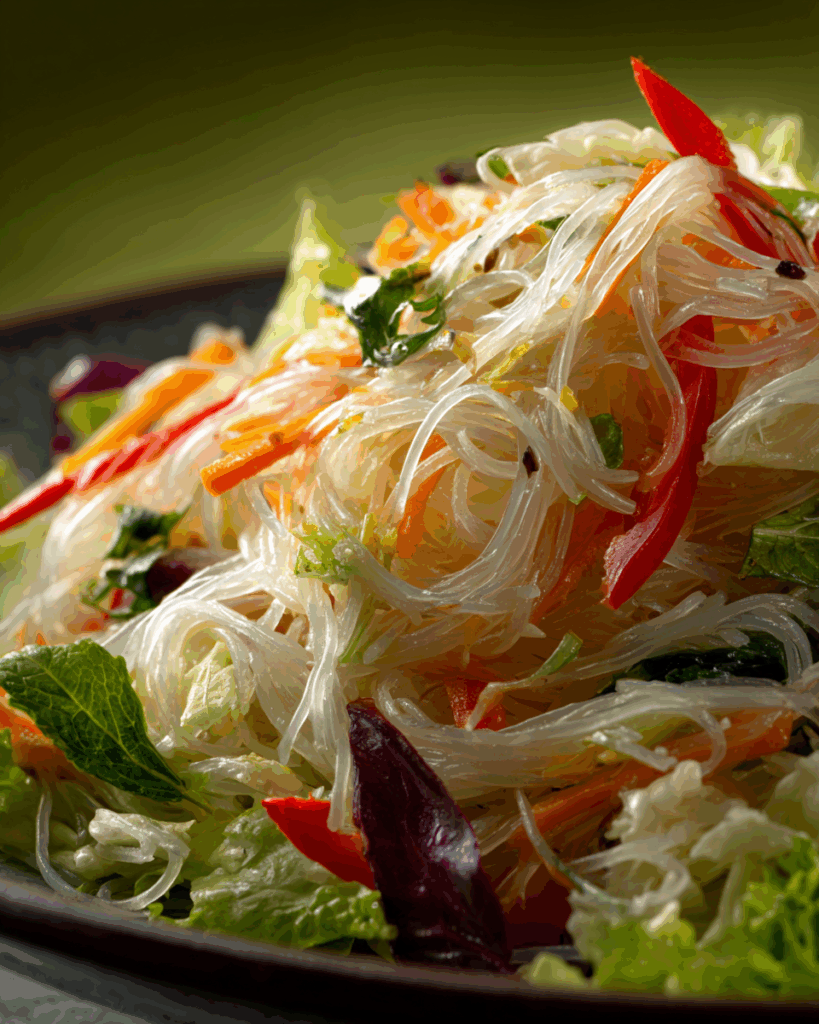
Is Thai Glass Noodle Salad Healthy?
Thai Glass Noodle Salad is widely regarded as a healthy dish because it combines lean protein, fresh vegetables, herbs, and light dressing without excessive oils or heavy sauces. The glass noodles themselves are low in fat and gluten-free, making them suitable for people with dietary restrictions. When paired with shrimp and ground pork, the salad provides a good mix of protein and carbohydrates, giving you energy without weighing you down. Additionally, the fresh herbs and lime juice in the dressing are rich in vitamins and antioxidants, which support immune health.
The dish is also naturally low in calories, particularly when compared to creamy Western salads. However, because the noodles are primarily starch, portion control is key if you’re watching your carbohydrate intake. Reducing the noodles and increasing the proportion of vegetables is an easy way to make it even lighter.
Nutritional Breakdown of Glass Noodles and Other Ingredients
To understand why this salad is both delicious and beneficial, here’s a closer look at its main components:
- Glass Noodles: Made from mung bean starch, these noodles are low in fat and provide a clean source of carbohydrates. They have a low glycemic index, which means they release energy slowly.
- Shrimp: High in protein and low in calories, shrimp adds a lean and nutrient-dense component to the salad. It’s also a good source of omega-3 fatty acids.
- Ground Pork: Adds protein and richness. Using lean pork keeps the dish healthy while delivering flavor.
- Fresh Vegetables (Tomato, Onion, Celery): Rich in fiber, vitamins, and minerals, these vegetables improve digestion and boost your immune system.
- Herbs (Cilantro, Mint): Provide antioxidants and detoxifying benefits while enhancing taste.
- Palm Sugar: A natural sweetener that’s less processed than refined sugar, though it should still be used in moderation.
- Fish Sauce and Lime Juice: Fish sauce adds umami without the need for excessive salt, and lime juice is an excellent source of vitamin C.
When eaten in moderation, Thai Glass Noodle Salad can easily fit into a balanced diet. Its fresh ingredients and minimal oil make it an ideal choice for anyone seeking a light but flavorful meal.
Popular Variations and Regional Twists
Yum Woon Sen with Prawns and Ground Pork
The most traditional and widely loved version of Thai Glass Noodle Salad combines both prawns and ground pork. The prawns add a sweet, oceanic flavor while the pork provides savory richness, making the salad balanced and satisfying. This combination is often found in Thai street markets, where vendors prepare it fresh with vibrant herbs and a spicy lime dressing.
Vegetarian Thai Glass Noodle Salad: A Healthier Alternative
For those following a plant-based diet, a vegetarian Thai glass noodle salad recipe is an excellent option. Instead of fish sauce, you can use soy sauce or tamari for a savory depth. Replace the pork and shrimp with tofu or edamame for added protein. Load up on vegetables such as shredded carrots, bell peppers, and cucumber to create a vibrant, nutrient-packed salad. The dressing can remain the same, simply adjusting the flavors to taste.
Authentic Thai Glass Noodle Salad (Old-Style Version)
Some traditional Thai households prepare an authentic Thai glass noodle salad using dried shrimp as the main protein, emphasizing the umami taste. This version often features a stronger dressing with more chilies and lime juice, resulting in a bolder and spicier flavor profile. The noodles are sometimes served slightly warm, which helps absorb the dressing better.
Yum Woon Sen with Seafood Mix
Apart from prawns, some regions of Thailand add a mix of seafood like squid, mussels, and even crab meat. This version highlights coastal Thai flavors and is commonly enjoyed in seaside towns where fresh seafood is abundant.
Yum Woon Sen with Extra Herbs and Spice
Certain Thai regions prefer their Yum Woon Sen to be on the fiery side. In these versions, extra Thai chilies are added to the dressing, along with additional herbs like mint and Thai basil, creating layers of refreshing heat. This style is perfect for spice lovers who want their salad to pack a punch.
Low-Carb Version of Thai Glass Noodle Salad
For those monitoring their carbohydrate intake, you can easily adapt this dish by reducing the quantity of glass noodles and replacing them with spiralized vegetables such as zucchini or cucumber. This low-carb version maintains the essence of the salad while offering a lighter alternative.
Yum Woon Sen with Extra Crunch
In some variations, toasted sesame seeds or crispy fried shallots are sprinkled over the salad to add another layer of texture. These additions create a contrast to the chewy noodles and soft proteins, making every bite exciting.
Regional Twists with Local Ingredients
Throughout Thailand, chefs often adapt the recipe with ingredients native to their area. Some versions incorporate green mango for tanginess, while others add roasted coconut flakes for a subtle sweetness. These regional twists keep the dish dynamic and showcase Thailand’s rich culinary diversity.
Serving Ideas and Pairings
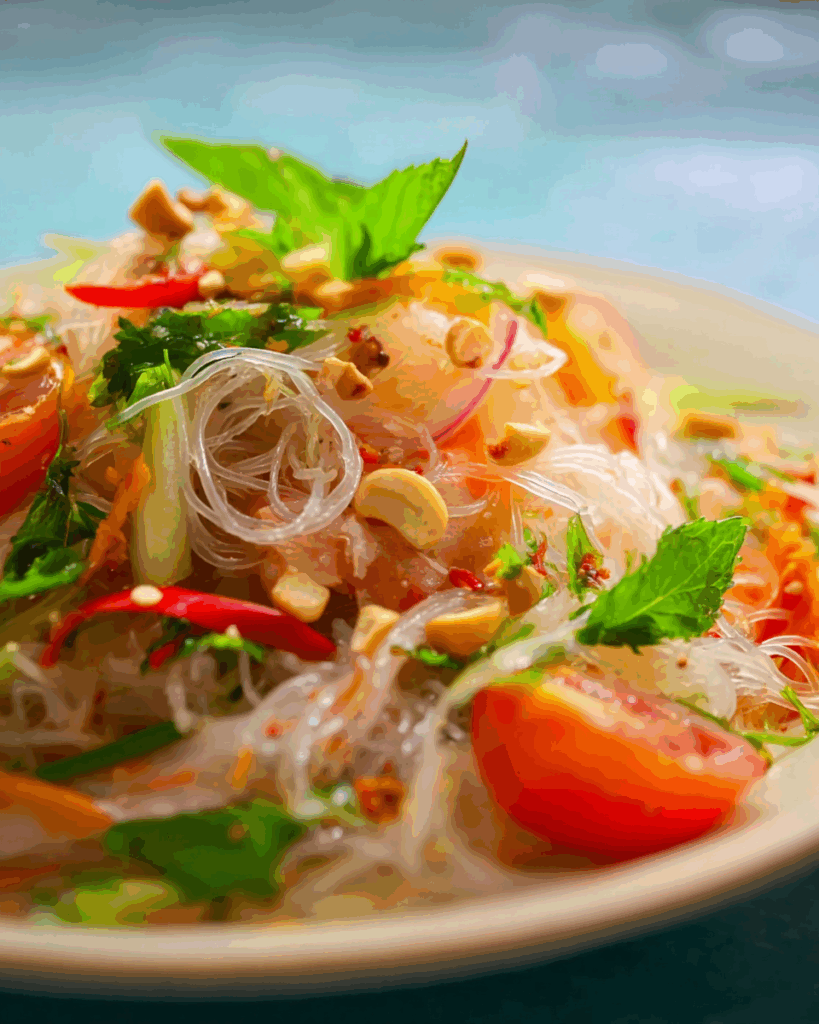
Traditional Ways to Serve Thai Glass Noodle Salad
Thai Glass Noodle Salad (Yum Woon Sen) is typically served as part of a shared meal rather than as a standalone dish. In Thailand, it is enjoyed at room temperature, often placed in the center of the table so everyone can take a portion. The salad is best prepared just before serving to keep the noodles from becoming soggy and to preserve the fresh crunch of the vegetables. Serving it in a wooden or bamboo bowl enhances the traditional presentation. A sprinkle of crushed peanuts and a few extra lime wedges on the side allow diners to adjust the flavor to their preference.
Another traditional serving method is to pair the salad with sticky rice or steamed jasmine rice. The mild rice balances the spiciness of the dressing, making each bite harmonious. Thai locals also love enjoying it with fresh lettuce leaves, wrapping portions of the salad in the leaves for a crisp, refreshing bite.
Best Thai Side Dishes to Serve Alongside
The refreshing and tangy flavors of Yum Woon Sen make it a perfect match for a variety of Thai dishes. Here are some ideas to create a full Thai dining experience:
- Thai Coconut Rice – Its creamy and mild taste perfectly complements the bold and spicy salad.
- Thai Fried Chicken – The crispy texture of fried chicken pairs beautifully with the lightness of the noodle salad.
- Thai Grilled Fish – Grilled fish seasoned with herbs and spices adds another layer of complexity to the meal.
- Tom Yum Soup – The hot and sour soup echoes the flavors of the salad, creating a balanced and flavorful Thai feast.
- Thai Desserts – End the meal with something sweet like mango sticky rice, Thai coconut pancakes, or Thai milk tea crème caramel to cool down the palate.
For those who love refreshing contrasts, serving Yum Woon Sen with chilled cucumber slices or Thai iced tea is another excellent option. The drink or side vegetables help tone down the spice while enhancing the salad’s zesty taste.
The key to serving this dish lies in maintaining its balance—make sure it stays vibrant, fresh, and full of life right up to the moment it hits the table.
Expert Tips for Perfecting the Salad
Common Mistakes to Avoid When Making Yum Woon Sen
Even though Thai Glass Noodle Salad is straightforward to prepare, a few mistakes can compromise its flavor and texture. Here are common pitfalls and how to avoid them:
- Overcooking the noodles: Glass noodles only need a quick 2-minute boil. Overcooking makes them mushy, and they won’t hold the dressing properly.
- Using too much dressing: While the dressing is the soul of Yum Woon Sen, drowning the salad in it can overpower the fresh ingredients. Add gradually and taste as you go.
- Skipping the herbs: Fresh herbs like cilantro are crucial. Without them, the salad loses its refreshing brightness.
- Adding dressing too early: Tossing the salad with dressing too far in advance makes the noodles absorb too much liquid, resulting in a soggy texture. Always dress the salad right before serving.
- Neglecting to balance flavors: The perfect Thai salad balances sour, sweet, spicy, and salty. Taste and adjust—sometimes a splash of lime or a pinch of sugar can make all the difference.
Pro Tips from Thai Chefs
Thai chefs follow a few secret techniques to elevate Yum Woon Sen from good to exceptional:
- Double dressing technique: Some chefs reserve a small portion of dressing to drizzle right before serving, enhancing freshness and aroma.
- Warm noodle toss: Tossing slightly warm noodles with the dressing allows them to soak in flavors more effectively.
- Layering flavors: Pound the garlic, chilies, and cilantro stems well to release essential oils, ensuring every bite is aromatic.
- Use of pork cooking liquid: Adding a tablespoon of the water used to cook ground pork adds depth and umami to the salad.
- Peanut garnish at the last moment: Always add crushed peanuts at the very end to maintain their crunch.
- Chill the serving bowl: In hot climates, some chefs chill the bowl before serving to keep the salad refreshing for longer.
By following these tips, you’ll consistently achieve the vibrant, flavorful, and perfectly textured salad that defines authentic Yum Woon Sen.
Conclusion and Final Thoughts
Why Thai Glass Noodle Salad Deserves a Spot in Your Kitchen
Thai Glass Noodle Salad (Yum Woon Sen) is more than just a salad—it’s an experience. With its vibrant colors, chewy noodles, refreshing herbs, and the iconic Thai balance of sweet, sour, salty, and spicy, it offers a burst of flavor in every bite. It’s also incredibly versatile, allowing you to adapt it to your preferences with options like prawns, pork, vegetarian versions, or even low-carb variations. Beyond taste, it’s healthy, easy to prepare, and perfect for any occasion, whether it’s a quick weeknight dinner or an impressive dish for a gathering.
This salad embodies the heart of Thai cuisine: simple ingredients transformed into something extraordinary through balance and technique. Once you’ve tried making it, it will likely become a staple in your kitchen. It’s the kind of dish that invites creativity—try regional twists, experiment with different herbs, and adjust spice levels to make it uniquely yours.
Where to Explore More Authentic Thai Recipes
For anyone inspired by the bold flavors of this dish, there’s a whole world of Thai recipes waiting to be explored. Lina, the creator behind Just Thai Recipes, has shared countless authentic dishes—from comforting curries to heavenly desserts—that bring the taste of Thailand to your home kitchen. Whether you want to master a spicy stir-fry or indulge in sweet Thai treats, the site is filled with step-by-step guides to help you cook like a local.
Don’t miss our Thai Red Rubies Dessert for a refreshing and colorful finish to any Thai meal. It pairs beautifully after a zesty serving of Yum Woon Sen, completing the authentic dining experience.
With all the tips, variations, and insights you’ve learned, it’s time to try making this delicious Thai Glass Noodle Salad yourself. Taste the balance, feel the freshness, and enjoy the satisfaction of bringing a piece of Thailand to your table.
FAQs
Is eating glass noodles healthy?
Glass noodles are low in fat and a good source of carbohydrates. They also have a lower glycemic index than many wheat-based noodles, releasing energy slowly. While they’re healthy when eaten in moderation, they’re still primarily starch, so balance them with proteins and vegetables for a complete meal.
What is Yum Woon Sen in English?
The Thai term Yum Woon Sen translates directly to “Spicy Glass Noodle Salad” in English. “Yum” refers to a Thai-style salad that’s typically spicy and tangy, while “Woon Sen” means glass noodles, which are transparent noodles made from mung bean starch.
Is Thai glass noodle salad healthy?
Yes. Thai glass noodle salad is a light, nutrient-packed dish. The noodles are low in fat and gluten-free, while the shrimp and pork provide lean protein. Fresh vegetables and herbs add vitamins and antioxidants, and the lime-based dressing is far healthier than creamy dressings. To make it even healthier, increase the proportion of vegetables or opt for a vegetarian version with tofu.
What is in a Thai glass noodle salad?
A traditional Thai glass noodle salad includes glass noodles, fresh shrimp, ground pork, dried shrimp, tomatoes, onions, and Chinese celery. It’s topped with roasted peanuts and fresh herbs, all tossed in a tangy dressing made of fish sauce, lime juice, garlic, chilies, and palm sugar. These ingredients create the dish’s signature balance of spicy, sour, sweet, and salty flavors.
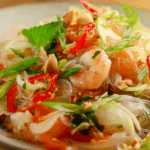
Thai Glass Noodle Salad
- Prep Time: 15 minutes
- Cook Time: 10 minutes
- Total Time: 25 minutes
- Yield: 2 servings 1x
- Category: Salad
- Method: Boiling and Mixing
- Cuisine: Thai
- Diet: Low Fat
Description
A vibrant Thai Glass Noodle Salad (Yum Woon Sen) featuring chewy glass noodles, fresh shrimp, ground pork, tangy lime dressing, and crunchy peanuts for a perfect balance of spicy, sour, and savory flavors.
Ingredients
- 1.4 oz dry glass noodles (bean threads or bean vermicelli)
- 1 Tablespoon dried shrimp (optional)
- 1 medium tomato, cut into wedges
- ¼ cup julienned onion
- 1 stalk Chinese celery or 2 inner small stalks of regular celery, thinly sliced
- 6 medium or large shrimp, peeled and deveined
- 3.5 oz ground pork
- 1 teaspoon fish sauce (for pork)
- ¼ cup roasted peanuts, roughly chopped
- 10 sprigs cilantro
- 2 cloves garlic
- 1–3 Thai chilies, to taste
- 1 Tablespoon palm sugar, finely chopped, packed
- 2 Tablespoons fish sauce (for dressing)
- 3 Tablespoons fresh lime juice
Instructions
- Soak glass noodles in room temperature water for 7-10 minutes until soft and pliable. Drain and cut into shorter lengths.
- Prepare the dressing: Pound cilantro stems, garlic, and chilies into a paste. Add palm sugar and pound until dissolved, then stir in fish sauce and lime juice until sugar is fully dissolved.
- Soften dried shrimp by soaking in hot water or microwaving with water, then drain and pound or chop into small pieces.
- Combine tomato, onion, Chinese celery, and dried shrimp in a large mixing bowl.
- Boil glass noodles for 2 minutes, then drain and set aside.
- Cook fresh shrimp in the same pot for 30-45 seconds until done, then add to the mixing bowl.
- Cook ground pork in a small amount of boiling water with fish sauce until fully cooked. Remove with a slotted spoon and add to the bowl, along with 1 tablespoon of the cooking liquid.
- Add noodles to the mixing bowl, pour the dressing over, and toss quickly to combine.
- Roughly chop the leafy cilantro sprigs and mix them into the salad. Sprinkle with roasted peanuts and serve immediately.
Notes
- Dried shrimp adds umami flavor but can be omitted for a milder taste.
- Adjust chili quantity based on preferred spice level.
- Serve immediately to enjoy the best texture of the noodles.
- Palm sugar can be substituted with brown sugar if unavailable.
Nutrition
- Serving Size: 1 bowl
- Calories: 280
- Sugar: 6g
- Sodium: 950mg
- Fat: 9g
- Saturated Fat: 2g
- Unsaturated Fat: 6g
- Trans Fat: 0g
- Carbohydrates: 30g
- Fiber: 3g
- Protein: 20g
- Cholesterol: 120mg
Keywords: Thai glass noodle salad, Yum Woon Sen, Thai salad recipe, spicy noodle salad, shrimp noodle salad

